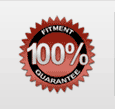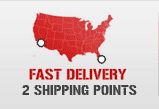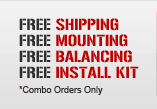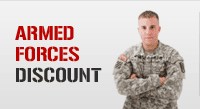Tires and Cornering

| TIRES AND CORNERING | |
SIMPLE PHYSICS |
|
| To fully understand what the wheels and tires go through when driving, you must learn about the principles of your vehicle?s suspension. When cornering, several forces you learned in physics class act on the vehicle as it turns and changes direction, which in turn, puts the tires under excessive stress and force. Below is a list of concepts you should be aware of that your vehicle goes through during a turn. | |
CENTRIFUGAL AND CENTRIPETAL FORCES |
|
| The centrifugal force pulls your vehicle toward the outside of the turn. This requires that an opposing and equal force counter it to ensure you corner safely and correctly. That opposing force is generated by the gripping power of the tires, which is known as cornering force. | |
 |
|
CORNERING FORCE |
|
| This is the frictional force generated by the cornering tires. It counters the centrifugal force listed above. The tire force is generated by tire slip, and when it comes to cornering, the slip angle is proportional to the tire force. | |
SLIP ANGLE |
|
| Slip angle is the deformation of the tire contact patch; the deflection of the patch deforms the tire. It is measured in how much the patch has been distorted in relation to the wheel during cornering. The cornering force increases in proportion to the occurrence and leads to the increase in the slip angle. Under normal driving conditions, you?ll find that the slip angle ranges from approximately 2 to 5 degrees with a maximum of 10 degrees. | |
SELF-ALIGNING TORQUE |
|
| This is the torque that occurs at the contact patch of the tires due to the friction involved in cornering. This will provide a major impact on the tire contact patch. | |
CORNERING POWER |
|
| This is the rate at which the cornering force increases as the slip angle increases. This is what determines driver handling, the higher cornering power, the higher cornering ability and stability of the vehicle. | |
TIRE AND CORNING FORCE/POWER |
|
| There are three key things to remember in terms of corning that apply across the board no matter the vehicle or the tire being used. First, remember that wet Surfaces decrease the friction which reduces the overall cornering force. Second, as the load increases, the cornering force also increases. You will experience a gradual decline in force should the load exceed the recommended value for the tire. Finally, tire stiffness increases the cornering power. This is seen with ?low profile? tire applications. The lower the profile the stiffer the sidewall can be, resulting in cornering power. | |
STEERING CHARACTERISTICS |
|
| Steering is the key element which guides your vehicle through turns. Its characteristics depend on the load distribution on the front and rear axles, as well as the cornering power of the tires. Here are the three biggest characteristics. |
|
 |
|
|
Oversteer This occurs during a turn and the rear tires lose traction. This leads to the rear of the vehicle to head towards the outside corner. Rear-wheel-drive vehicles are most prone to oversteer, especially through tight cornering. Understeer Understeer is a condition in which the circular path of the vehicle?s motion is of a larger diameter than what is indicated by the direction the wheels are pointing. Neutral Steer This is a cornering condition that the front and rear slip angles are the same. Though it seems as an ideal state of balance, this is not as stable as slight Understeer. |
|
Popular Rims and Tires Links
Black Rims and Tires Chrome Rims and Tires Cheap Rims and Tires Wheels Bargains 14 Inch Rims and Tires 15 Inch Rims and Tires 16 Inch Rims and Tires 17 Inch Rims and Tires 18 Inch Rims and Tires 19 Inch Rims and Tires 20 Inch Rims and Tires 21 Inch Rims and Tires 22 Inch Rims and Tires 24 Inch Rims and Tires 26 Inch Rims and Tires 28 Inch Rims and Tires Rims and Tires Specials Wheel and Tire Packages Rims and Wheels Brands Tires Brands 15 Inch Tires 16 Inch Tires 17 Inch Tires 18 Inch Tires 19 Inch Tires 20 Inch Tires 22 Inch Tires 24 Inch Tires 26 Inch Tires Cheap Tires Tire Specials All Tires Forged Rims and Tires Custom Rims 1 Piece Wheels Information 3 Piece Wheels InformationPopular Car Rims Webpages
Acura RSX Rims Acura Integra Rims Audi A4 Rims BMW 3-Series Rims Cadillac Escalade Rims Chevy Cavalier Rims Chevy 1500 Rims Chevy Silverado Rims Crysler 300 Rims Chevy Tahoe Rims Dodge Charger Rims Dodge Magnum Rims Dodge Neon Rims Dodge Ram Rims Ford Expedition Rims Ford Explorer Rims Ford Focus Rims Ford Mustang Rims Ford F-150 Rims GMC Yukon Rims Honda Civic Rims Honda Accord Rims Hyundai Santa Fe Rims Infiniti G37 and G35 Rims Mercedes S-Class Rims Mitsubishi Eclipse Rims Mitsubishi Lancer Rims Nissan 350Z Rims Scion tC Rims Scion xB Rims Subaru Impreza Rims Toyota Camry Rims Toyota Celica Rims Toyota Corolla Rims Volkswagen Beetle Rims Volkswagen Jetta RimsCopyright 2008 - 2025 © RimsDealer.com, INC. All rights reserved. Development and SEO by HighTechWeb, INC.









